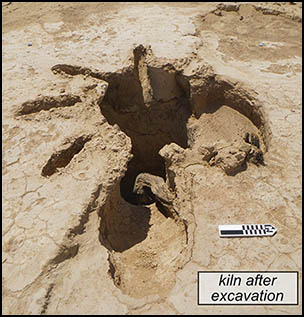Crossref Citations
This article has been cited by the following publications. This list is generated based on data provided by
Crossref.
Luneau, Élise
2019.
Socio-Environmental Dynamics along the Historical Silk Road.
p.
275.
Haruda, A.F.
Varfolomeev, V.
Goriachev, A.
Yermolayeva, A.
and
Outram, A.K.
2019.
A new zooarchaeological application for geometric morphometric methods: Distinguishing Ovis aries morphotypes to address connectivity and mobility of prehistoric Central Asian pastoralists.
Journal of Archaeological Science,
Vol. 107,
Issue. ,
p.
50.
Rouse, Lynne M.
Grillo, Katherine M.
Piermartiri, Roberta
Rotondaro, Eleonora
Cogo-Moreira, Hugo
Bargossi, Giuseppe Maria
and
Cerasetti, Barbara
2019.
Not just “nomadic jars”: The Late Bronze Age ceramic assemblage from the mobile pastoralist site of Ojakly, Murghab region, Turkmenistan.
Archaeological Research in Asia,
Vol. 18,
Issue. ,
p.
100.
Motuzaite Matuzeviciute, Giedre
Tabaldiev, Kubatbek
Hermes, Taylor
Ananyevskaya, Elina
Grikpedis, Mindaugas
Luneau, Elise
Merkyte, Inga
and
Rouse, Lynne M.
2020.
High-Altitude Agro-Pastoralism in the Kyrgyz Tien Shan: New Excavations of the Chap Farmstead (1065–825 cal b.c.).
Journal of Field Archaeology,
Vol. 45,
Issue. 1,
p.
29.
Rouse, Lynne M.
2020.
Silent partners: archaeological insights on mobility, interaction and civilization in Central Asia’s past.
Central Asian Survey,
Vol. 39,
Issue. 3,
p.
398.
Rollinger, Robert
2020.
Short-term Empires in World History.
p.
189.
Spengler, Robert N.
Miller, Alicia Ventresca
Schmaus, Tekla
Matuzevičiūtė, Giedrė Motuzaitė
Miller, Bryan K.
Wilkin, Shevan
Taylor, William Timothy Treal
Li, Yuqi
Roberts, Patrick
and
Boivin, Nicole
2021.
An Imagined Past?.
Current Anthropology,
Vol. 62,
Issue. 3,
p.
251.
Schreiber, Finn
2022.
Social and chronological aspects of the Late Bronze age burial site of Kokcha 3 (Uzbekistan).
Journal of Archaeological Science: Reports,
Vol. 44,
Issue. ,
p.
103508.
Kroll, Sonja
Bendezu-Sarmiento, Julio
Lhuillier, Johanna
Luneau, Élise
Kaniuth, Kai
Teufer, Mike
Mustafakulov, Samariddin
Khasanov, Mutalib
Vinogradova, Natalia
Avanesova, Nona
Fiorillo, Denis
Tengberg, Margareta
Sharifi, Arash
Bon, Céline
Bosch, Delphine
and
Mashkour, Marjan
2022.
Mobility and land use in the Greater Khorasan Civilization: Isotopic approaches (87Sr/86Sr, δ18O) on human populations from southern Central Asia.
Journal of Archaeological Science: Reports,
Vol. 46,
Issue. ,
p.
103622.
Plekhov, Daniel
and
Levine, Evan I.
2022.
Defining Suitability in Mixed Agropastoral Societies: A Case Study from Bactria in Northern Afghanistan.
Environmental Archaeology,
Vol. 27,
Issue. 4,
p.
372.
Rouse, Lynne M.
Woldekiros, Helina S.
and
Cerasetti, Barbara
2022.
Faunal remains from Ojakly, a Late Bronze Age mobile pastoralist campsite in the Murghab region, Turkmenistan.
Journal of Archaeological Science: Reports,
Vol. 44,
Issue. ,
p.
103531.
Billings, Traci N.
Cerasetti, Barbara
Forni, Luca
Arciero, Roberto
Dal Martello, Rita
Carra, Marialetizia
Rouse, Lynne M.
Boivin, Nicole
and
Spengler, Robert N.
2022.
Agriculture in the Karakum: An archaeobotanical analysis from Togolok 1, southern Turkmenistan (ca. 2300–1700 B.C.).
Frontiers in Ecology and Evolution,
Vol. 10,
Issue. ,
Tan, Liangcheng
Cheng, Hai
Li, Dong
Orozbaev, Rustam
Li, Yanzhen
Xu, Hai
Edwards, R. Lawrence
Song, Yougui
Ma, Le
Lin, Fangyuan
Sinha, Ashish
and
An, Zhisheng
2024.
Hydroclimatic changes on multiple timescales since 7800 y BP in the winter precipitation–dominated Central Asia.
Proceedings of the National Academy of Sciences,
Vol. 121,
Issue. 14,
Rouse, Lynne M.
Haruda, Ashleigh
Hunter, Sydney A.
and
Kroll, Sonja
2025.
Meta‐analysis of an integrated archaeobiological and environmental dataset: Revealing hidden trends in Chalcolithic and Bronze Age socio‐economies in southern Central Asia.
Archaeometry,
Vol. 67,
Issue. 2,
p.
457.



